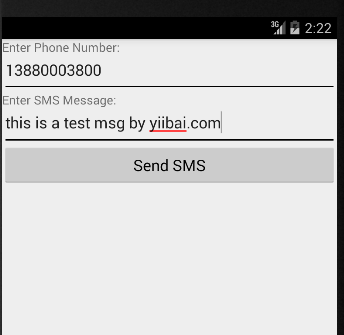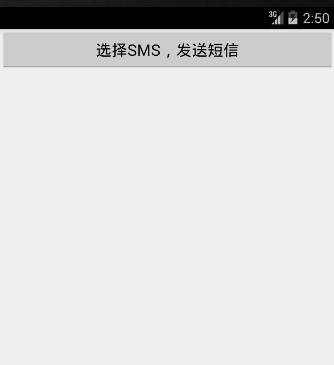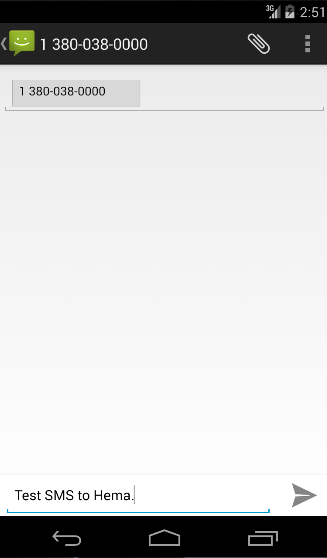Android发送短信/SMS
有以下两种方式来使用 Android 设备发送短信:
-
使用 SmsManager 发送短信
-
使用内置 Intent 发送短信
使用SmsManager 发送短信
SmsManager管理,例如在给定的移动设备将数据发送到的SMS操作。可以创建此对象调用静态方法SmsManager.getDefault() 如下:
SmsManager smsManager = SmsManager.getDefault();
创建 SmsManager 对象之后,可以使用 sendDataMessage() 方法指定的手机号码发送短信,如下:
smsManager.sendTextMessage("phoneNo", null, "SMS text", null, null);
除了上述方法外,SmsManager类可供选择的其他几个重要的函数。下面列出了这些方法:
| S.N. | 方法和说明 |
|---|---|
| 1 |
ArrayList<String> divideMessage(String text) 这个方法把一个消息文本分成几个片段,最大不能大于短信大小 |
| 2 |
static SmsManager getDefault() 这个方法被用来获取 SmsManager 的默认实例 |
| 3 |
void sendDataMessage(String destinationAddress, String scAddress, short destinationPort, byte[] data, PendingIntent sentIntent, PendingIntent deliveryIntent) 这个方法被用来发送一个基于数据 SMS 到特定的应用程序的端口 |
| 4 |
void sendMultipartTextMessage(String destinationAddress, String scAddress, ArrayList<String> parts, ArrayList<PendingIntent> sentIntents, ArrayList<PendingIntent> deliveryIntents) 发送一个基于多部分文本短信 |
| 5 |
void sendTextMessage(String destinationAddress, String scAddress, String text, PendingIntent sentIntent, PendingIntent deliveryIntent) 发送基于文本的短信 |
示例
下面的示例演示如何在实际中使用 SmsManager 对象给定的手机号码发送短信。
要尝试这个例子中,需要实际配备了最新 Android OS 的移动设备,否则仿真器可能无法正常工作。
| 步骤 | 描述 |
|---|---|
| 1 | 使用Android Studio 创建Android应用程序,并将它命名为SendSMSDemounder。在创建这个项目,确保目标 SDK 编译在Android SDK 的最新版本或使用更高级别的API |
| 2 | 修改 src/MainActivity.java 文件,并添加所需的代码以发送短信 |
| 3 | 修改所需的布局XML文件 res/layout/activity_main.xml 添加任何GUI组件。加入了一个简单的GUI以输入手机号码并短信发送,以及一个简单的按钮发送短信。 |
| 4 | 修改 res/values/strings.xml 定义所需的常量值 |
| 5 | 修改 AndroidManifest.xml 如下所示 |
| 6 | 运行该应用程序启动Android模拟器并验证应用程序所做的修改结果。 |
以下是修改的主活动文件 src/com.yiibai.sendsmsdemo/MainActivity.java 的内容
package com.example.sendsmsdemo; import android.os.Bundle; import android.app.Activity; import android.telephony.SmsManager; import android.util.Log; import android.view.Menu; import android.view.View; import android.widget.Button; import android.widget.EditText; import android.widget.Toast; public class MainActivity extends Activity { Button sendBtn; EditText txtphoneNo; EditText txtMessage; @Override protected void onCreate(Bundle savedInstanceState) { super.onCreate(savedInstanceState); setContentView(R.layout.activity_main); sendBtn = (Button) findViewById(R.id.btnSendSMS); txtphoneNo = (EditText) findViewById(R.id.editTextPhoneNo); txtMessage = (EditText) findViewById(R.id.editTextSMS); sendBtn.setOnClickListener(new View.OnClickListener() { public void onClick(View view) { sendSMSMessage(); } }); } protected void sendSMSMessage() { Log.i("Send SMS", ""); String phoneNo = txtphoneNo.getText().toString(); String message = txtMessage.getText().toString(); try { SmsManager smsManager = SmsManager.getDefault(); smsManager.sendTextMessage(phoneNo, null, message, null, null); Toast.makeText(getApplicationContext(), "SMS sent.", Toast.LENGTH_LONG).show(); } catch (Exception e) { Toast.makeText(getApplicationContext(), "SMS faild, please try again.", Toast.LENGTH_LONG).show(); e.printStackTrace(); } } @Override public boolean onCreateOptionsMenu(Menu menu) { // Inflate the menu; this adds items to the action bar if it is present. getMenuInflater().inflate(R.menu.main, menu); return true; } }
下面是 res/layout/activity_main.xml 文件的内容:
<LinearLayout xmlns:android="http://schemas.android.com/apk/res/android" android:layout_width="fill_parent" android:layout_height="fill_parent" android:orientation="vertical" > <TextView android:id="@+id/textViewPhoneNo" android:layout_width="wrap_content" android:layout_height="wrap_content" android:text="@string/phone_label" /> <EditText android:id="@+id/editTextPhoneNo" android:layout_width="fill_parent" android:layout_height="wrap_content" android:inputType="phone"/> <TextView android:id="@+id/textViewMessage" android:layout_width="wrap_content" android:layout_height="wrap_content" android:text="@string/sms_label" /> <EditText android:id="@+id/editTextSMS" android:layout_width="fill_parent" android:layout_height="wrap_content" android:inputType="textMultiLine"/> <Button android:id="@+id/btnSendSMS" android:layout_width="fill_parent" android:layout_height="wrap_content" android:text="@string/send_sms_label"/> </LinearLayout>
下面文件 res/values/strings.xml 的内容中定义两个新的常量:
<?xml version="1.0" encoding="utf-8"?> <resources> <string name="app_name">SendSMSDemo</string> <string name="action_settings">Settings</string> <string name="hello_world">Hello world!</string> <string name="phone_label">Enter Phone Number:</string> <string name="sms_label">Enter SMS Message:</string> <string name="send_sms_label">Send SMS</string> </resources>
以下是AndroidManifest.xml 文件的默认内容:
<?xml version="1.0" encoding="utf-8"?> <manifest xmlns:android="http://schemas.android.com/apk/res/android" package="com.yiibai.sendsmsdemo" android:versionCode="1" android:versionName="1.0" > <uses-sdk android:minSdkVersion="8" android:targetSdkVersion="17" /> <uses-permission android:name="android.permission.SEND_SMS" /> <application android:allowBackup="true" android:icon="@drawable/ic_launcher" android:label="@string/app_name" android:theme="@style/AppTheme" > <activity android:name="com.yiibai.sendsmsdemo.MainActivity" android:label="@string/app_name" > <intent-filter> <action android:name="android.intent.action.MAIN" /> <category android:name="android.intent.category.LAUNCHER" /> </intent-filter> </activity> </application> </manifest>
我们尝试运行 SendSMSDemo 应用程序。Eclipse的AVD上安装的应用程序,并启动它,如果一切的设置和应用代码都没有问题,它会显示以下模拟器窗口:

选择移动设备作为一个选项,然后检查移动设备,这将显示以下画面:

现在可以输入手机号码及文本消息并发送。最后点击"Send SMS"按钮发送短信。请确保GSM连接工作正常,以及提供正确的短信收件人。
可以把一些短信用逗号分隔,在程序中把它解析为一个数组的字符串,最后可以使用一个循环来发送消息给所有给定的手机号码。下一节将学习如何使用现有的 SMS 客户端发送短信。
使用内置Intent发送短信
发送短信通过调用Android内置短信功能,可以使用Android的Intent。以下部分说明使用 Intent 对象发送短信的功能。
Intent对象 - 发送短信动作
使用ACTION_VIEW 动作启动 Android 设备上安装 SMS 客户端。以下是简单的语法来创建一个 Intent 来使用 ACTION_VIEW 动作
Intent smsIntent = new Intent(Intent.ACTION_VIEW);
Intent对象 - 数据/发送短信类型
要发送的短信需要使用SetData()方法指定 smsto: 作为URI和数据类型将使用 setType() 方法如下vnd.android-dir/mms-sms:
smsIntent.setData(Uri.parse("smsto:")); smsIntent.setType("vnd.android-dir/mms-sms");
Intent 对象- 附加发送短信
Android已经内置支持添加电话号码和短信发送短信如下:
smsIntent.putExtra("address" , new String("0123456789;3393993300")); smsIntent.putExtra("sms_body" , "Test SMS to Angilla");
这里address 和sms_body是大小写敏感的,应以小字符指定。可以指定一个以上的号码在单串,但由分号(;) 隔开。
示例
下面的示例演示如何在实际使用Intent对象启动SMS客户端发送短信给定的收件人。
要尝试这个例子中,需要实际配备了最新的 Android OS的移动设备,否则仿真器可能无法正常工作。
| 步骤 | 描述 |
|---|---|
| 1 | 使用Android Studio创建Android应用程序,并将它命名为SendSMSDemounder,创建这个项目,确保目标 SDK编译在Android SDK的最新版本或使用更高级别的API。 |
| 2 | 修改src/MainActivity.java文件,并添加所需的代码,以发送短信。 |
| 3 | 修改所需的布局XML文件 res/layout/activity_main.xml 添加任何GUI组件。添加一个简单的按钮用来触发启动SMS客户端。 |
| 4 | 修改 res/values/strings.xml 定义所需的常量值 |
| 5 | 修改 AndroidManifest.xml 如下所示 |
| 6 | 运行该应用程序启动Android模拟器并验证应用程序所做的修改结果。 |
以下是修改主活动文件 src/com.yiibai.sendsmsdemo/MainActivity.java 的内容
package com.example.sendsmsdemo; import android.net.Uri; import android.os.Bundle; import android.app.Activity; import android.content.Intent; import android.util.Log; import android.view.Menu; import android.view.View; import android.widget.Button; import android.widget.Toast; public class MainActivity extends Activity { @Override protected void onCreate(Bundle savedInstanceState) { super.onCreate(savedInstanceState); setContentView(R.layout.activity_main); Button startBtn = (Button) findViewById(R.id.sendSMS); startBtn.setOnClickListener(new View.OnClickListener() { public void onClick(View view) { sendSMS(); } }); } protected void sendSMS() { Log.i("Send SMS", ""); Intent smsIntent = new Intent(Intent.ACTION_VIEW); smsIntent.setData(Uri.parse("smsto:")); smsIntent.setType("vnd.android-dir/mms-sms"); smsIntent.putExtra("address" , new String ("0123456789")); smsIntent.putExtra("sms_body" , "Test SMS to Angilla"); try { startActivity(smsIntent); finish(); Log.i("Finished sending SMS...", ""); } catch (android.content.ActivityNotFoundException ex) { Toast.makeText(MainActivity.this, "SMS faild, please try again later.", Toast.LENGTH_SHORT).show(); } } @Override public boolean onCreateOptionsMenu(Menu menu) { // Inflate the menu; this adds items to the action bar if it is present. getMenuInflater().inflate(R.menu.main, menu); return true; } }
下面是 res/layout/activity_main.xml 文件的内容:
<LinearLayout xmlns:android="http://schemas.android.com/apk/res/android" android:layout_width="fill_parent" android:layout_height="fill_parent" android:orientation="vertical" > <Button android:id="@+id/sendSMS" android:layout_width="fill_parent" android:layout_height="wrap_content" android:text="@string/compose_sms"/> </LinearLayout>
下面文件 res/values/strings.xml 的内容中定义两个新的常量:
<?xml version="1.0" encoding="utf-8"?> <resources> <string name="app_name">SendSMSDemo</string> <string name="hello_world">Hello world!</string> <string name="action_settings">Settings</string> <string name="compose_sms">Compose SMS</string> </resources>
以下是AndroidManifest.xml 文件的默认内容:
<?xml version="1.0" encoding="utf-8"?> <manifest xmlns:android="http://schemas.android.com/apk/res/android" package="com.yiibai.sendsmsdemo" android:versionCode="1" android:versionName="1.0" > <uses-sdk android:minSdkVersion="8" android:targetSdkVersion="17" /> <application android:allowBackup="true" android:icon="@drawable/ic_launcher" android:label="@string/app_name" android:theme="@style/AppTheme" > <activity android:name="com.yiibai.sendsmsdemo.MainActivity" android:label="@string/app_name" > <intent-filter> <action android:name="android.intent.action.MAIN" /> <category android:name="android.intent.category.LAUNCHER" /> </intent-filter> </activity> </application> </manifest>
我们尝试运行 SendSMSDemo 应用程序。 Eclipse AVD安装的应用程序,并启动它,如果一切设置和应用都没有问题,它会显示以下模拟器窗口:

选择移动设备作为一个选项,然后检查移动设备,这将显示以下画面:

现在使用Compose SMS“按钮推出Android内置的SMS客户端,如下图所示:

可以修改默认字段最后使用发送短信按钮(标有红色矩形)提到收件人发送短信。
以上示例代码下载:http://pan.baidu.com/s/1c0Ah508

